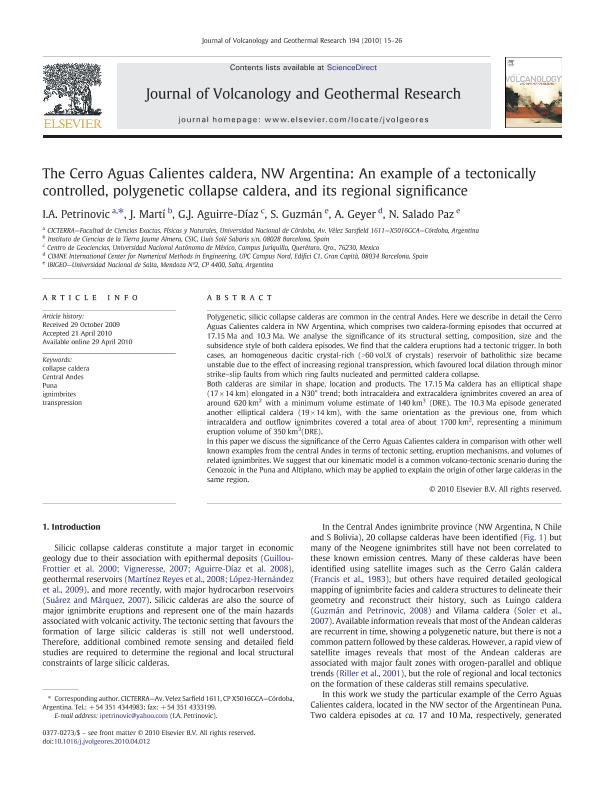Mostrar el registro sencillo del ítem
dc.contributor.author
Petrinovic, Ivan Alejandro

dc.contributor.author
Martí, J.
dc.contributor.author
Aguirre Díaz, G. J.
dc.contributor.author
Guzman, Silvina Raquel

dc.contributor.author
Geyer, A.
dc.contributor.author
Salado Paz, Natalia

dc.date.available
2018-07-13T15:40:30Z
dc.date.issued
2010-07
dc.identifier.citation
Petrinovic, Ivan Alejandro; Martí, J.; Aguirre Díaz, G. J.; Guzman, Silvina Raquel; Geyer, A.; et al.; The Cerro Aguas Calientes caldera, NW Argentina: An example of a tectonically controlled, polygenetic collapse caldera, and its regional significance; Elsevier Science; Journal of Volcanology and Geothermal Research; 194; 1-3; 7-2010; 15-26
dc.identifier.issn
0377-0273
dc.identifier.uri
http://hdl.handle.net/11336/52025
dc.description.abstract
Polygenetic, silicic collapse calderas are common in the central Andes. Here we describe in detail the Cerro Aguas Calientes caldera in NW Argentina, which comprises two caldera-forming episodes that occurred at 17.15. Ma and 10.3. Ma. We analyse the significance of its structural setting, composition, size and the subsidence style of both caldera episodes. We find that the caldera eruptions had a tectonic trigger. In both cases, an homogeneous dacitic crystal-rich (>60. vol.% of crystals) reservoir of batholithic size became unstable due to the effect of increasing regional transpression, which favoured local dilation through minor strike-slip faults from which ring faults nucleated and permitted caldera collapse.Both calderas are similar in shape, location and products. The 17.15Ma caldera has an elliptical shape (17×14km) elongated in a N30° trend; both intracaldera and extracaldera ignimbrites covered an area of around 620km2 with a minimum volume estimate of 140km3 (DRE). The 10.3Ma episode generated another elliptical caldera (19×14km), with the same orientation as the previous one, from which intracaldera and outflow ignimbrites covered a total area of about 1700km2, representing a minimum eruption volume of 350km3(DRE).In this paper we discuss the significance of the Cerro Aguas Calientes caldera in comparison with other well known examples from the central Andes in terms of tectonic setting, eruption mechanisms, and volumes of related ignimbrites. We suggest that our kinematic model is a common volcano-tectonic scenario during the Cenozoic in the Puna and Altiplano, which may be applied to explain the origin of other large calderas in the same region. © 2010 Elsevier B.V.
dc.format
application/pdf
dc.language.iso
eng
dc.publisher
Elsevier Science

dc.rights
info:eu-repo/semantics/openAccess
dc.rights.uri
https://creativecommons.org/licenses/by-nc-sa/2.5/ar/
dc.subject
Central Andes
dc.subject
Collapse Caldera
dc.subject
Ignimbrites
dc.subject
Puna
dc.subject
Transpression
dc.subject.classification
Meteorología y Ciencias Atmosféricas

dc.subject.classification
Ciencias de la Tierra y relacionadas con el Medio Ambiente

dc.subject.classification
CIENCIAS NATURALES Y EXACTAS

dc.title
The Cerro Aguas Calientes caldera, NW Argentina: An example of a tectonically controlled, polygenetic collapse caldera, and its regional significance
dc.type
info:eu-repo/semantics/article
dc.type
info:ar-repo/semantics/artículo
dc.type
info:eu-repo/semantics/publishedVersion
dc.date.updated
2018-07-11T14:17:11Z
dc.journal.volume
194
dc.journal.number
1-3
dc.journal.pagination
15-26
dc.journal.pais
Países Bajos

dc.journal.ciudad
Amsterdam
dc.description.fil
Fil: Petrinovic, Ivan Alejandro. Consejo Nacional de Investigaciones Científicas y Técnicas. Centro Científico Tecnológico Conicet - Córdoba. Centro de Investigaciones en Ciencias de la Tierra. Universidad Nacional de Córdoba. Facultad de Ciencias Exactas Físicas y Naturales. Centro de Investigaciones en Ciencias de la Tierra; Argentina
dc.description.fil
Fil: Martí, J.. Consejo Superior de Investigaciones Científicas. Instituto de Ciencias de la Tierra Jaume Almera; España
dc.description.fil
Fil: Aguirre Díaz, G. J.. Universidad Nacional Autónoma de México; México
dc.description.fil
Fil: Guzman, Silvina Raquel. Consejo Nacional de Investigaciones Científicas y Técnicas. Centro Científico Tecnológico Conicet - Salta. Instituto de Bio y Geociencias del NOA. Universidad Nacional de Salta. Facultad de Ciencias Naturales. Museo de Ciencias Naturales. Instituto de Bio y Geociencias del NOA; Argentina
dc.description.fil
Fil: Geyer, A.. CIMNE International Center for Numerical Methods in Engineering; España
dc.description.fil
Fil: Salado Paz, Natalia. Consejo Nacional de Investigaciones Científicas y Técnicas. Centro Científico Tecnológico Conicet - Salta. Instituto de Bio y Geociencias del NOA. Universidad Nacional de Salta. Facultad de Ciencias Naturales. Museo de Ciencias Naturales. Instituto de Bio y Geociencias del NOA; Argentina
dc.journal.title
Journal of Volcanology and Geothermal Research

dc.relation.alternativeid
info:eu-repo/semantics/altIdentifier/doi/https://dx.doi.org/10.1016/j.jvolgeores.2010.04.012
dc.relation.alternativeid
info:eu-repo/semantics/altIdentifier/url/https://www.sciencedirect.com/science/article/pii/S0377027310001307
Archivos asociados
